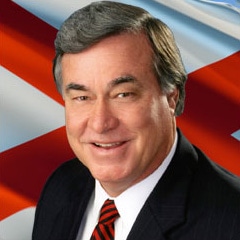When talk turns to politics in Alabama it usually leads to the Governor’s race. It does not matter if the Governor’s race is four years away, political gossip starts early as to who will run for Governor. In Alabama politics the Governor’s office is the brass ring. As each new race approaches it is talked about more than ever around coffee clubs and kitchen tables from Sand Mountain to the Wiregrass. It is comparable to college football being the king of all sports in Alabama.
This infatuation with the Governor’s office is borne out in voting history. In most states the Presidential race sees the largest voter turnout, but that is not the case in Alabama where historically we have voted heavier in gubernatorial years. However the turnout has gotten closer in the last few decades ever since Alabama became a two party state. The emergence of the Republican Party in Alabama since 1964 has caused us to be more like the national norm. However, in the 40 years prior, the largest turnout in Alabama was in the Democratic Primary for Governor.
Gubernatorial years also have most of the important local offices up for grabs, which may account for some of the large turnout. There is a popular political saying, made famous by former U.S. House Speaker Tip O’Neil, that “all politics is local.” Next year is a local year with all 67 Sheriffs on the ballot as well as all 105 House members and 35 State Senators. The Governor’s race along with the other Constitutional offices, such as Lt. Governor, Attorney General, Secretary of State, State Auditor, Treasurer, and Agricultural Commissioner, will also be on the ballot. It should be an interesting and exciting year.
Alabamians have fallen into a pattern of voting Republican for our Washington politicians. It appears we prefer Republican Presidents, U.S. Senators, and Congressmen, while we split our allegiance when it comes to the Statehouse. However, we overwhelmingly elect Democrats to local offices such as Probate Judge, Sheriff, and the Legislature.
In recent years the middle battleground has been the Governor’s office, a job we have not placed a party preference on. In the last 20 years we have seen extremely close gubernatorial elections and political party musical chairs. In 1986 Guy Hunt became the first Republican Governor since Reconstruction, but left office in 1992 only to be succeeded by Democrat Jim Folsom Jr. Fob James won as a Republican in a close 1994 race but lost to Democrat Don Siegelman in 1998. Siegelman lost to Republican Bob Riley in a squeaker in 2002. In the 20 year stretch prior to 1986 there was very little swapping because George Wallace was Governor most of that time.
Look for a lot of negative ads and attacks next year. Why, because it works. The book on Alabama politics, according to George Wallace, is that more people will vote against someone or something than for someone or something. Wallace ran against integration for years and when that wore out he ran against the big money special interests and corporations. “Big Jim” Folsom ran against the same big mules. Sadly polling reveals that negative or attack ads are effective. Wallace and Folsom knew this instinctively before polling and used it effectively.
Wallace shared another interesting caveat with me. He said he would rather someone say he was going to win than they were going to vote for him. This is called the bandwagon effect. People like to vote for the winner. They say, “I don’t want to waste my vote.”
In keeping with the tradition of enjoying the Governor’s race, I will begin a 15-week series on past Governor’s races. Beginning next week, I will take one Governor’s race each week and extol and delve into the intricacies of the gubernatorial contest for that year beginning with the 1958 Governor’s race and ending with 2006. The 15-week series should whet your appetite for the upcoming 2010 Governor’s race. Hopefully, the series will be an enjoyable stroll down memory lane for many of you. Those of you who are younger readers should find the next 15 weeks of Alabama political history informative.

Steve Flowers
Alabama’s premier columnist and commentator, Steve has analyzed Alabama politics for national television audiences on CBS, PBS, ABC and the British Broadcasting Network. Steve has been an up close participant and observer of the Alabama political scene for more than 50 years and is generally considered the ultimate authority on Alabama politics and Alabama political history.